Matador Network's Blog, page 799
August 24, 2020
National parks are free on August 25

In celebration of the National Park Service’s 104th birthday and to encourage people to get outside and visit America’s beautiful national parks, the National Park Service is waiving entrance fees to all parks on August 25.
In a press release, the NPS said, “On August 25, 1916, President Woodrow Wilson signed the legislation establishing the National Park Service. At the same time, women across the country were fighting to guarantee their right to vote throughout the United States, a right that would finally be recognized when the 19th Amendment became part of the US Constitution on August 26, 1920, the day after the fourth birthday of the National Park Service.”
The NPS has granted free entry days to celebrate its birthday in the past, though this year will look a little different. Due to COVID-19, many major facilities in the parks may be closed, camping may be restricted, and getting a reservation could prove difficult. The NPS also recommends that people wear face coverings inside the parks, especially in highly populated areas. The NPS recommends that everyone check the park website to determine its operating status before visiting.
If you happen to miss this particular free entrance day, there’s two more coming up this year. The next is on September 26 in celebration of National Public Lands Day, and there’s another on November 11 for Veterans Day. 
More like thisParks + WildernessThe best uncrowded state parks near the five busiest national parks
The post All US national parks will be free on August 25 appeared first on Matador Network.

Sark Island is looking for residents

Moving to a remote island is a pretty tantalizing prospect right now. Luckily, the small island of Sark, one of the Channel Islands between England and France, is looking for new residents.
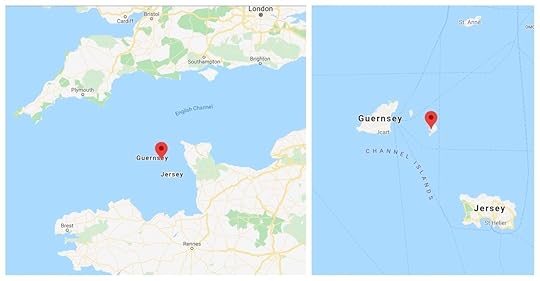
Photo: Google Maps
The island has fewer than 500 permanent residents, no cars, and the only transportation is bicycle or horse-drawn carriage. Now, German entrepreneur Swen Lorenz, who has lived on the island since 2004, is trying to boost the island’s population by persuading people to move there.
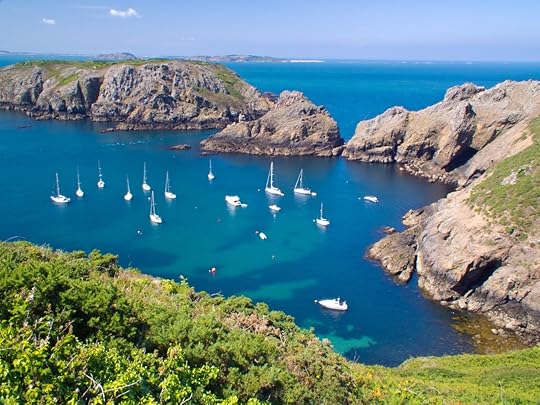
Photo: Keri Billen Photography/Shutterstock
On the Sark Society website, Swen Lorenz invites people to “Live in a place with stunning scenery and a low-density population, pay minimal taxes, and free yourself from excessive government regulation, and be part of a group of like-minded entrepreneurs, investors, and freethinkers.”

Photo: Allard One/Shutterstock
Lorenz outlines how easy it is to move to the island, citing the lack of employment law, no income or personal asset disclosure, no income tax, and no accounting requirements. Citizens of the UK and Ireland can move there without a visa, while US and EU citizens must apply for an employment, investor, or entrepreneur visa — all of which are relatively easy to obtain.
Sark is a “dependency” island with some level of autonomy, though still under the jurisdiction of the UK. There is no airport, and the island is only accessible by boat from the nearby islands of Guernsey and Jersey, and from France. 
More like thisBeaches + Islands7 surreal car-free islands in the US
The post This idyllic island in the English Channel is looking for new residents appeared first on Matador Network.

Best Airbnbs on Kauai, Hawaii
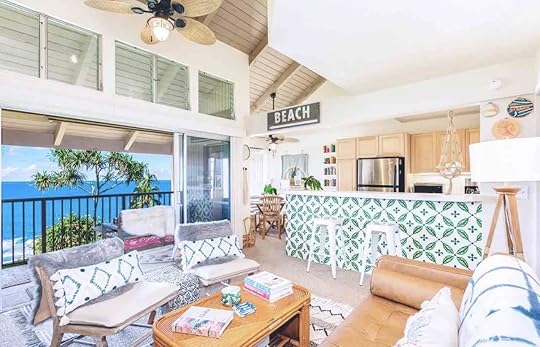
Like it or not, 2020 is the year of domestic travel. While we wait impatiently for international travel to return, our attention turns inward as we consider adventures within our own borders. Road trips are more popular than ever, but they’re not for everyone. Many of us want nothing more than to arrive at a beachside resort or tropical cabin, throw on some shades and tune out the world for a while. This might seem incongruous with a domestic trip right now, but you’re forgetting one important destination: Hawaii. Come September, United States citizens can escape to paradise without ever leaving the country. As long as you meet the testing requirements, nothing is stopping you from enjoying a sunny, quarantine-free island vacation next month. There’s really only one question left to answer. Where to stay?
Kauai, the oldest of the Hawaiian islands, is covered in rainforests, white beaches, state parks, waterfalls, and other natural wonders. You might think that a lengthy stay would drain your bank account, but that’s actually not the case. These Airbnbs on Kauai are not only breathtaking but also surprisingly affordable. From a cabin in the mountains to oceanfront villas, these are the best Airbnbs on Kauai.
1. Modern villa, Koloa
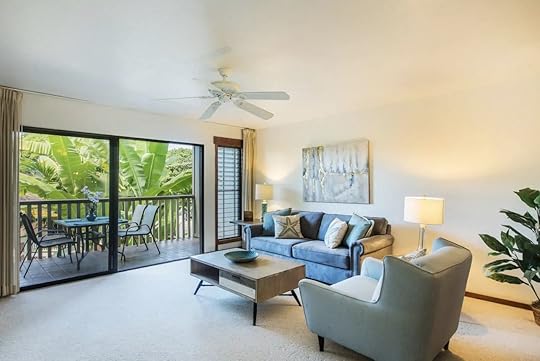
Photo: Airbnb
Located in a resort community in Koloa, this modern villa is surrounded by tropical gardens and some of the island’s best beaches. As a guest of the resort you have access to the property’s two pools, and you’ll be within walking distance of restaurants and shops. Just across the street you’ll find Koloa Landing, a favorite spot for diving and snorkeling, and the Sheraton, Lawai, Kiahuna, Poipu, and Brennecke beaches all within striking distance.
Price: $109 per night
2. Cedar Cabins, Kokee Park
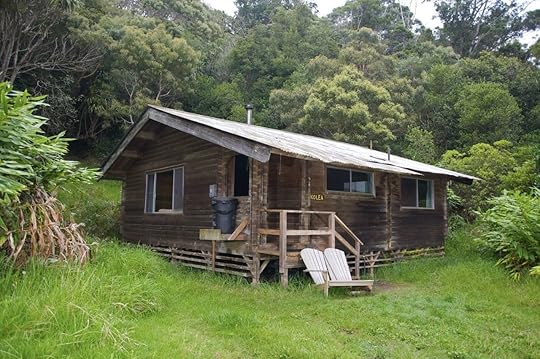
Photo: Airbnb
The Cedar Cabins might be the most unique accommodation in Kauai. If you really want to get out of the busy resort atmosphere and plunge into the island’s rustic side, these cabins in Kokee Park are the ideal choice. Located 3,000 feet up in the mountains, the cabins are within walking distance to some of the park’s best hiking trails and give you the perfect base for exploring Waimea Canyon. Since it can get chilly at that elevation, don’t be surprised if you find yourself building a fire to stay warm at night.
Price: $120 per night
3. Sunny condo, Poipu Beach

Photo: Airbnb
Within walking distance to snorkeling and surfing on Poipu Beach, this one-bedroom condo is also close to the area’s restaurants, shopping centers, and even a golf course. The prime, central location of this sunny condo, combined with its tropical decor, make it the perfect couples getaway on Kauai.
Price: $159 per night
4. Makai Golf Club cottage, Makai Resort

Photo: Airbnb
On the north shore of Kauai, the Makai Golf Club cottage is ideal for those who want to use their tropical getaway to improve their golf game. The two-bedroom accommodation is right next to the Makai Golf Club — and several beaches — giving you easy access to a relaxing round of 18 surrounded by some of the island’s most stunning scenery. As a guest of the cottage, you’ll also have access to a pool, hot tub, fire pit, bike rentals, and BBQ grills.
Price: $161 per night
5. Two-bedroom townhouse with putting green, Poipu Beach
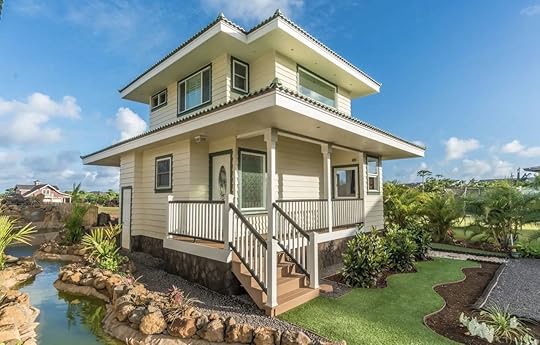
Photo: Airbnb
Staying in Poipu gives you the best of both worlds: the beach and mountain views. This one-bedroom townhouse sweetens the deal by giving you access to your own putting green and is just five minutes away from the Kiahuna golf course. In addition to the putting green, the property also has a custom waterfall and creek to really make you feel immersed in Hawaii’s natural beauty. If you do eventually get bored of hanging out at the house, Poipu Beach is known for its diving, snorkeling, and surfing, as well as opportunities for viewing monk seals.
Price: $199 per night
6. The Surf Shack, Princeville

Photo: Airbnb
The Surf Shack in Princeville certainly lives up to its name. This two-bedroom house is defined by aesthetic touches like vintage tiki shot glasses, a curated newspaper filled with local pictures, surfboards hanging from the wall, and other homey beach house decor. The place even has its own Instagram page. Guests can even stroll down a paved trail to a private Hideaways beach, where there’s a swimming pool and hot tub.
Price: $199 per night
7. Garden Isle Oasis, Wyllie Beach
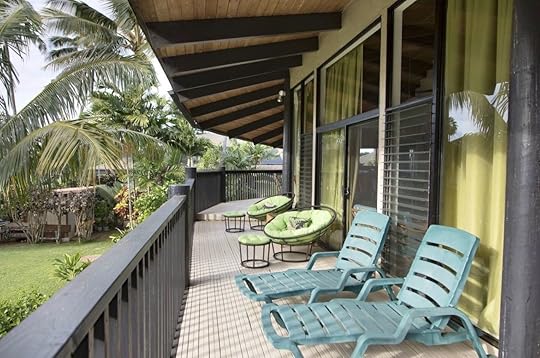
Photo: Airbnb
This place doesn’t take the name “oasis” lightly. The two-bedroom garden apartment has wicker furnishings, tropical turquoise walls, and a wrap-around veranda with both sunrise and sunset views. Floor-to-ceiling windows allow for tons of natural light and a view of the lush gardens surrounding the complex. Located in the north of the island, it also includes a pool and is close to several hiking trails and popular kayaking spots like Hanalei Bay.
Price: $250 per night
8. Romantic Garden Cottage, Wainiha River
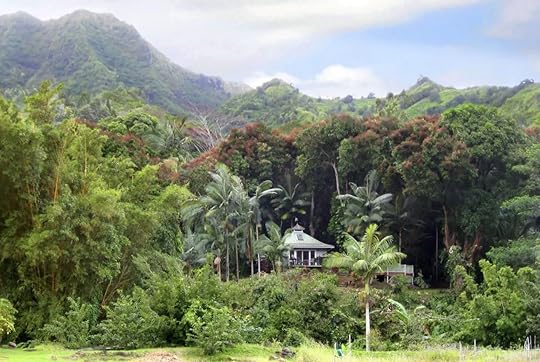
Photo: Airbnb
On a secluded acre of land along the Wainiha River, this garden cottage offers stunning views of the river valley and a private pool and spa. The property is defined by its garden filled with exotic birds, flowers, and fruit trees growing papayas and bananas, and leads down to a private stream where you can go swimming. It’s also just two miles away from some of the island’s most beautiful beaches on the north shore. If you’re looking for a restorative getaway surrounded by nature, it doesn’t get any better than this.
Price: $275 per night
9. Oceanfront condo, Kauai Shores

Photo: Airbnb
This private one-bedroom condo on the east coast of Kauai has one of the most unobstructed views of the ocean anyone could hope for. From the veranda, you’ll have a front-row seat to watch the sea turtles and whales playing in the water. Just steps away from Lawai Beach, the condo is furnished with floor-to-ceiling patio doors that ensure you always have a view. It’s also just a five-minute drive from the National Tropical Botanical Gardens and Spouting Horn Park, where you can take a break from the beach to hike through the native greenery.
Price: $290 per night 
More like thisBeaches + IslandsWhy Kauai is the most underrated island in Hawaii
The post 9 stunning yet affordable Airbnbs on Kauai, Hawaii appeared first on Matador Network.

August 21, 2020
Most charming small Maine towns

If 12 years of Murder She Wrote on television has taught us anything, it’s that living in beautiful Maine is the dream. Well, so long as you don’t specifically live in fictional Cabot Cove, dear Jessica Fletcher’s hometown with an alarmingly high murder rate. The state’s small coastal towns are some of the prettiest in the nation, and they make for tranquil destinations for travelers looking for a peaceful seaside escape. So, if you decide to take on a foliage-peeping trip around New England this fall, make sure to stop by some of Maine’s coastal small towns to revisit the charming vibe of the popular television series — and to chow down on some lobster, of course.
1. Kennebunkport

Photo: PhotoItaliaStudio/Shutterstock
Kennebunkport is where the summer home of the Bush family is located, but don’t let that scare you — the town is not a hoity toity hub for the rich. Granted there are grand homes around, but many of these are former sea captain mansions turned into inns where travelers can rest their legs while checking out the views of the ocean. Because, of course, it’s all about the ocean in Kennebunkport.
The town was a seasonal destination for Native Americans for thousands of years before European settlements in the 17th century, and it became a center for ship-building in the 18th century. It was in the 19th century that Kennebunkport became a magnet for city-dwellers looking to enjoy the warm months by the sea, and it has remained that way ever since. The area’s beaches are perfect for a spot of relaxation, but if you want to be more active, you can take to the water in more ways than you had imagined — fishing, whale watching, kayaking, paddleboarding, surfing, and sailing are all available.
There’s also great boutique shopping and dining in town for those who are less interested in catching fish than in eating them — try The Clam Shack for some of the most celebrated lobster rolls in the country. If you can’t make it to Kennebunkport in the fall, try Christmas. The Kennebunkport Christmas Prelude is often touted as one of the best holiday celebrations in the nation with tree-lighting ceremonies, craft fairs, seafood chowder luncheons and lobster dinners, parades, and more. Kennebunkport is located only one hour and 30 minutes north of Boston, and just 40 minutes from Portland, ME.
2. Castine

Photo: mark stephens photography/Shutterstock
The village that was the actual inspiration for Cabot Cove, Castine could not have a more tantalizing slogan — “Under the Elms and by the Sea” really sets the scene for some serious New England magic. The village is a small but popular tourist destination located on a peninsula in Penobscot Bay about 250 miles from Boston and 140 miles from Portland. The main appeal is clearly the beauty of its old homes and grand inns like the 19th-century Pentagöet Inn, but the beaches, lighthouses, and historic sites are just as alluring as the New England architecture.
Take a theme cruise to see the area’s many lighthouses, including Acadia National Park’s famous Bass Harbor Lighthouse (the park is less than 50 miles away), and to get some of that fresh sea air everyone raves about. Being one of the oldest towns in the state, Castine is a great place for those who want to add a touch of culture to their trip. The village is on the National Historic Register and 1884 Fort Knox is just a 25 minute drive away. While you’re there, take in views with a side of great engineering at the Penobscot Narrows Bridge and Observatory — taller than the Statue of Liberty and the tallest public bridge observatory in the world, it’s a local attraction that’s hard to miss.
3. Vinalhaven
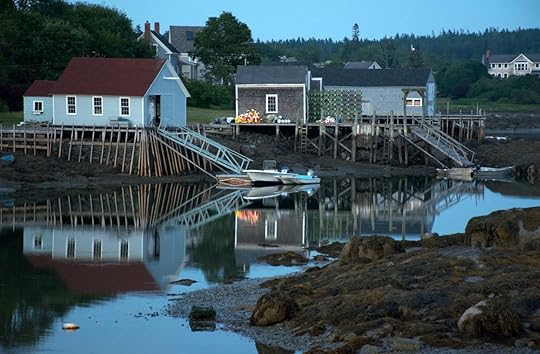
Photo: Derek Young/Shutterstock
To get away from it all, leave the mainland behind and head to the island of Vinalhaven. Also located in the Penobscot Bay, you need to hop in the ferry in Rockland to get there (the crossing is one hour and 15 minutes), making the town of about 1,200 permanent inhabitants a little less busy than other pretty coastal villages in the state — even in the high season.
That’s not to say that Vinalhaven is overlooked; there are many parks and preserves on the island with over 17 miles of trail to hike, so day visitors are a common sight, but you won’t encounter any large crowd. For a true Maine experience, check out the Browns Head Lighthouse on the northwest side of the island, only eight miles away from the village. The tower is closed, but you can explore the grounds and take in the spectacular views.
The main industry in Vinalhaven is lobster fishing, and the town is one of the top lobster landing ports in the state with 200 lobster boats moored in Carver’s Harbor. And that means there’s some good grub to be had. For a casual but delicious lunch, head to food truck Greet’s Eats for lobster and crab rolls.
4. Machias

Photo: Harry Collins Photography/Shutterstock
Only 30 miles from the Canadian border in New Brunswick, Machias is over three and a half hours away from Portland and over five hours away from Boston. While the rest of Maine is lobster and crab crazy, Machias is obsessed with blueberries — there’s even a summer festival dedicated to the small fruit that’s been going on for 45 years, with music, comedy, craft fairs, pie-eating contests, cooking contests, and more.
There are historic sites worth checking out in and around Machias, but the local fauna is the real clincher for potential visitors. Take a boat tour to Machias Seal Island in the lower Bay of Fundy, an island shared by the US and Canada that serves as a migratory bird sanctuary, to get the chance to observe Atlantic puffins, Arctic terns, razorbills and many more — over 100 species have been spotted there. The island is closed to visitors in June and July to protect the nesting birds, but you can visit outside of these two months. Note that the island is very popular with nature- and bird-lovers, so you won’t have the place to yourself.
Beyond the birds, the still-functioning octagonal lighthouse is worth a visit, and make sure to wave to the Canadian lightkeepers who are stationed there. Several companies offer tours and most depart from the small town of Cutler just 15 minutes by car from Machias, but think about booking in advance since it’s a popular day trip.
5. Boothbay Harbor
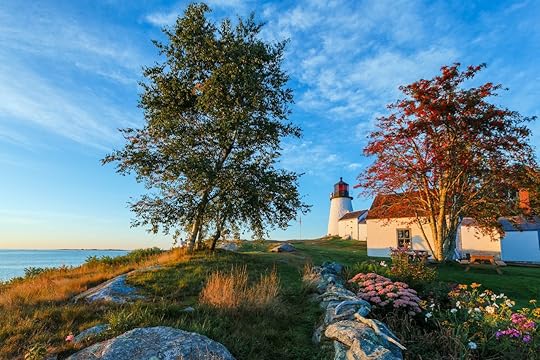
Photo: davidmarxphoto/Shutterstock
Boothbay Harbor has a serious reputation for being very scenic, so much so in fact that it’s a well-known wedding destination for those who want the craggy shorelines and traditional lighthouses as backgrounds to their special day. But even if you’re not getting hitched, you’ll enjoy this small town, whether outside on one of the many boat excursions leaving its harbor daily, on nearby Burnt Island for a tour of the lighthouse, on its more than 20 miles of nature trails, at its famously stunning botanical gardens, or inside in the art galleries, unique shops, theaters, and arts and crafts markets.
If you’re passionate about maritime history and tradition, or if you just enjoy wooden boats, visit during the annual Windjammer Days that take place in June every year to see some of the most beautiful ships in this corner of the Atlantic Ocean. Christmas is also a particularly good time to visit as Boothbay Harbor goes all out during its Harbor Lights Festival with more than half a million lights strung all over the place, including on sailboats that parade through the harbor and bring Santa to town. Boothbay Harbor is about one hour from Portland and less than three hours from Boston.
6. Ogunquit

Photo: haveseen/Shutterstock
Ogunquit is on the southern Maine coast, just 50 minutes southwest of Portland and only one hour and 20 minutes from Boston. It’s therefore a very accessible vacation spot for city folks, and it has everything one hopes to find to relax during their time off work: miles of sandy beach and a trolley system that allows you to explore without the need of a car. And if you’re the active kind, you won’t even need to get in the trolley because everything in Ogunquit is within walking or biking distance.
Marginal Way is an easy coastal walking path that connects Ogunquit to the picture-perfect lobstering village of Perkins Cove, and it delivers on amazing views. Once in Perkins Cove, enjoy the traditional clapboard homes, visit the locally owned shops, and get some food in you, whether lobster or saltwater taffies. If you’re keen to get in the water, there’s some good surfing at the Ogunquit Rivermouth, and the Ogunquit River is perfect for an afternoon of kayaking.
Of course, like every good coastal town in Maine, there are boat tours available to see lighthouses, whales, or go fishing, but Ogunquit is more than just a seaside destination — it’s also very artsy. So, if you want to shake it up a little, check out the Ogunquit Museum of American Art and attend a performance at the highly acclaimed Ogunquit Playhouse.
7. Camden

Photo: E.J.Johnson Photography/Shutterstock
A very popular destination in the summer (the population of the town triples during July and August), Camden is even better in the fall — and not only because it’s much, much quieter. The coastal town of Camden is bordered by hills, so it’s a stunning place to go foliage-peeping, and the best way to enjoy the red, orange, and yellow hues of the season is to hike Mount Battie in Camden Hills State Park. From there, the view of the town, Penobscot Bay, and the surrounding hills will make you weak in the knees (the hike is short and of moderate difficulty).
If you’d rather enjoy the scenery from the water, rent a sea kayak and do your own thing, or take part in a tour that will take you around nearby Curtis Island. If you have no intention of exercising on your vacation, hop in a schooner for an excursion or tour around Penobscot Bay — if you’re lucky, you’ll be allowed to steer and raise sails.
Camden is a little upscale, but don’t let that keep you away; strolling around the town center, visiting the beautiful 1928 public library, hiking, spending time on the beach, and checking out lighthouses won’t cost you a penny and will deliver a perfect coastal Maine experience. If you can’t make it in the fall, visit during winter when the area’s ski hills come alive. Camden is less than two hours east of Portland and three and a half hours away from Boston. 
More like thisFood + DrinkWhy Portland, Maine, is the ultimate fall food getaway
The post 7 small Maine coastal towns for puffins, craggy shores, and delicious seafood appeared first on Matador Network.

Rare white killer whale in Alaska
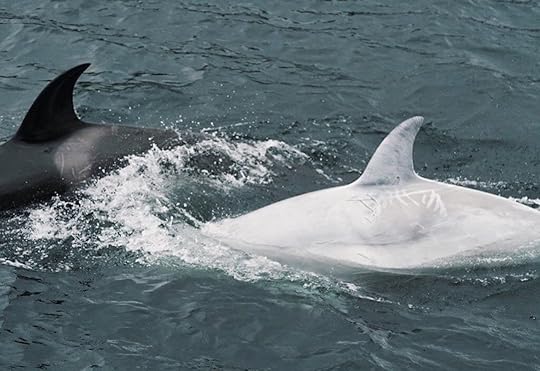
A white killer whale was spotted off the coast of Southeast Alaska earlier this month by researchers on a charter boat. The rare whale was swimming amongst a pod of fellow orcas and stood out immediately from the crowd. Killer whales are usually black an white, but this particular whale was solid white — an extremely rare occurrence.
It’s so rare that Dennis Rogers, the captain of the ship, said it was the first white killer whale he has ever seen in his 45-plus years of sailing the waters of southeast Alaska. Rogers even got a second look at the whale a few days later from his window overlooking the ocean in Petersburg. As before, the whale was swimming with its pod.
Stephanie Hayes, a graduate student at the University of Alaska Fairbanks and the first mate on the boat, said in a press release, “There have only been about eight white killer whales ever recorded in the world. To have one in Southeast was an incredible phenomenon.”
The rare whale is thought to have a condition called leucism, a DNA mutation that causes a lack of vibrancy in skin pigmentation.
“Not just to be able to see it,” said Hayes, “but to be able to see it hunting with the pod, was beyond what I could have ever hoped for as a scientist. Hopefully, we can monitor it and find out what happens in the life of a white killer whale.”
The whale had already been documented by British Columbia researchers and named Tl’uk, meaning “bright moon” in the language of the Salish people of the Pacific Northwest. It was spotted in the Puget Sound in Washington in April 2020. The two-year-old whale may encounter difficulties later in life due to its coloring, but for now he’s certainly a welcome sight. 
More like thisWildlifeWhere to swim with the world’s most amazing marine wildlife
The post A rare white killer whale was spotted in the waters of Southeast Alaska appeared first on Matador Network.

Big Basin state park fire damage
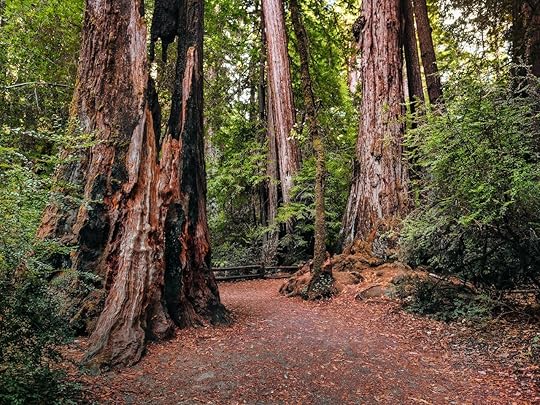
Wildfires in California continue to devastate everything on their paths, including Big Basin Redwoods State Park. The oldest state park in California suffered extensive damage from the CZU August Lightning Complex Fires in Santa Cruz County and is now closed until further notice. The fire damaged the park headquarters, historic core, and campgrounds. Nearly all the redwood trees were scorched, reports The Mercury News.
The Big Basin Redwoods State Park Headquarters & Visitor Center was left in ruins following a blaze that swept through the park#CZULightningComplexFire #wildfire pic.twitter.com/08ZR04G1hq
— Randy Vazquez (@RandyVMedia) August 21, 2020
Luckily, redwood trees tend to be extremely resilient due to their thick bark. According to Sam Hodder of Save the Redwoods League, “Obviously if they were big enough and hot enough to take those structures, there’s no way to tell. We’re just crossing our fingers until we have a chance to get in there and take a look. It’s that balance between heartbreak and the resilience that redwoods have taught us, trying to gear ourselves up for the process of building back.”
One of the trees near the Big Basin Redwoods State Park headquarters burns from within. #BigBasin #CZULightningComplexFire #wildfires pic.twitter.com/p8zhW9ROhb
— Randy Vazquez (@RandyVMedia) August 21, 2020
Also, fortunately, everyone at the Little Basin and Big Basin were evacuated before the flames could claim any lives. The flames from the CZU Lightning Complex Fires continue to burn outside Big Basin as fire departments struggle to get the blaze under control. 
More like thisWellnessThe best places in the US to try forest bathing
The post California’s oldest state park has been devastated by wildfire appeared first on Matador Network.

Road trip stops in South Dakota
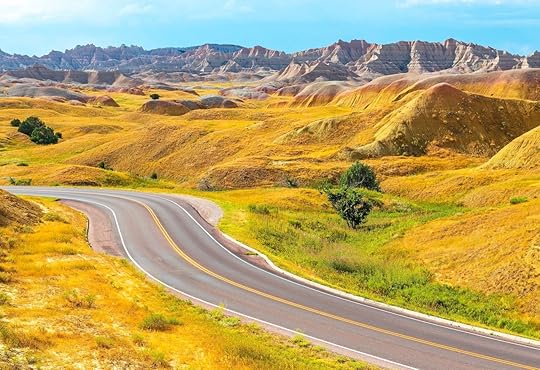
“My dog Bambino wrote all of this,” Wayne Porter says as we read poetry in his sculpture park just outside Sioux Falls, SD above Interstate 90. “He’s the brains of this operation. But I have the opposable thumb.”
His point is well taken. The poetry describes the 50-plus sculptures at the eponymous Porter Sculpture Park, and the wrought-iron figures would have been hard to do with paws. I tell him they make a pretty good team.
“I know,” he says. “He’s a good dog.”

Photo: Laura Grier
Porter might seem a bit eccentric anywhere other than the world of South Dakota roadside attractions. But in a state that’s made itself into the United States premier drive-through destination, he’s yet another reason to pull off the road.
South Dakota is the northern vestibule between the east and the great national parks of the west. Its highways are filled with dinosaurs, sculpture parks, classic cars, and rideable jackalopes. Which is why no American road trip is complete without discovering the roadside treasures that wait off the highways of South Dakota.
Begin the trip in one of the US’ best small cities
Sioux Falls is South Dakota’s largest city with around 180,000 people, and it’s likely the first place you’ll encounter other than pit stops for gas on any trip in the region. If you don’t know much about it other than the address on your credit card bill, that’s fine. Sioux Falls revels in its place as an under-hyped small city, but it will win you over within a night.
Posting up at the historic Hotel on Phillips, I saw how the city has transformed from a regional hub for the eastern Dakotas into one of those small cities that seems to do everything right. The hotel’s craft cocktail bar, Treasury, could have come from any city 20 times Sioux Falls’ size, with creative drinks and an attractive young crowd inside. Across the street, I found Woodgrain Brewing, where professionals from the city came for after-hours drinks. Pedal bars full of bachelorette parties biked by. I realized that this city was the place to go for anyone within 200 miles looking for a good time.
The next morning I went for a run on the city’s immaculate greenway, which winds along the Big Sioux River through Falls Park and the quartz rock canyons that line the city’s famous waterfalls. It reminded me that on a smaller scale, many cities are still beautiful, cultural places with few problems. And that’s part of the magic of traveling through South Dakota.
A park with a sculptor as riveting as his artwork

Photo: Laura Grier
About half an hour outside Sioux Falls, I noticed a multi-story bull’s head and a full-sized Trojan horse standing on a bright green hillside. These are what lured me into the Porter Sculpture Park and led to reading dog poetry with one of South Dakota’s most colorful characters.
The 18-acre park features more than 50 of former sheep farmer Wayne Porter’s original wrought-iron creations, ranging from that 60-foot bull’s head with the Creature from The Black Lagoon hanging inside to druid priests, butterflies, and a massive Trojan horse.
“That horse took me ten years,” Porter grumbles through the wind whipping over the hillside. “We still don’t get along. He kicked the shit out of me.”
The sculptures alternate with white boards sporting poems that explain the artwork. Porter insists Bambino wrote all of them.
“You live here a little while, you start to flip over the edge,” he says. “You start talking like sheep. Baaa! Baaa!”
In the distance, Bambino comes running.
Dam good corny puns abound
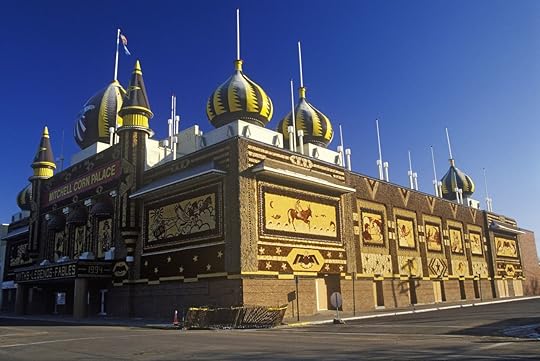
Photo: Joseph Sohm/Shutterstock
If there’s one thing the region loves almost as much as roadside attractions, it’s puns. I learned this when venturing south off I-90 and into Yankton, where I crossed the Gavins Point Dam to the Dam Fish Shack in Crofton, NE.
“Matt, your dam order is ready!” a child of about twelve yelled through a cardboard megaphone. “MATT…your DAM order is ready!”
The shack is a funky roadside outdoor eatery by the Missouri River with picnic tables, $2 craft beers, and a sunny patio that would draw hours-long weekend waits in a big city. Here, it’s just a quick place to grab a fish sandwich or buffalo burger after a long afternoon of fishing.
The pun-tastic adventure continued as I headed an hour and a half north of Yankton to Mitchell, home of the world’s only Corn Palace. It’s an arena and events center that looks like a Russian Orthodox church covered in corn, with turrets and minarets standing atop facades decked out in corn-cob murals. Each is made of a dozen different corn varieties, utilizing over 350,000 ears. The murals change each year with different themes, and the building is as important to Mitchell as the Eiffel Tower is to Paris.
Everyone here leans into the corn.
“We’ll say ‘are you corn-fused’ or ‘that’s a-maize-ing,’” Sonya Moller, the chief operations officer of Mitchell’s Convention and Visitors’ Bureau, told me as we perused the Corn-cession stand. “The high school team’s called the Kernels. Their mascot is Cornelius. We have all sorts of ‘em!”
Because it’s such an icon, the Corn Palace has grown from a venue to a community center and point of pride for everyone who lives nearby. And between its behemoth testament to corn and the endless puns, Mitchell’s a runaway winner for corniest town in the US.
An auto museum run by a man as entertaining as the cars
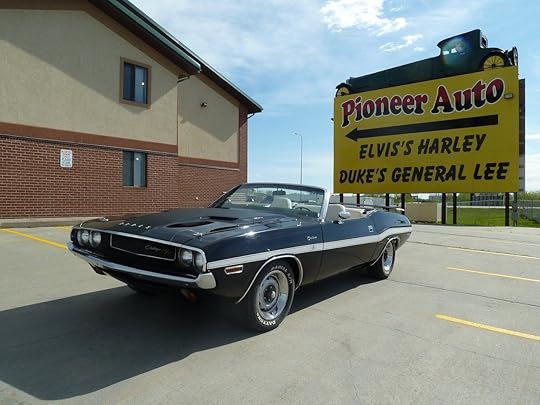
Photo: Pioneer Auto Show/Facebook
Continuing west on I-90 from Mitchell, you’ll see billboards for the Pioneer Auto Show in Murdo, the world’s most impressive car museum in the middle of nowhere.
It’s a display of over 250 classic cars ranging from an original Ford Model A, to a Lamborghini tractor, to entire barns of 1930s gangster cars. All are shown in historic buildings donated to the museum, like the old one-room schoolhouse and the vintage WNAX gas station.
“Let me show you something,” owner Dave Geisler Sr. says as he meets me at the front of the museum after entertaining a family from Minnesota. The 82-year old, who spent years on the South Dakota tourism board, hobbles into the museum’s first room and leans over a bright orange Dodge Charger. “You know what this is?”
“The General Lee?” I answer, assuming there was no other reason for a 1968 Dodge Charger to be in an auto museum in the middle of South Dakota unless it had been featured on The Dukes of Hazzard.
He leans in the window and honks the horn. It blurts out an auto-horn rendition of “Dixie.” Completely ignoring my response, he says, “That’s an original General Lee!”
Geisler takes me into another room with an original Yoda puppet. Then he gets a quarter from the cashier to show off a rare antique, animatronic big band Coke machine. He tells me stories about the time people from the show American Pickers came through, and he empties a box of press clippings about the museum onto a table at the attached restaurant.
“We’ve had everybody in here!” he brags.
Geisler’s been hosting people on this plateau in Murdo for decades, and he’s as much a fixture in the South Dakota countryside as green rolling hills and cattle. His children run most of the business now, but the eldest Geisler sticks around to entertain the dozens of curious road-trippers who stop in every day.
“It’s kind of like owning a farm,” the younger Dave Greisler tells me later in his office. “You own 10,000 acres, that land’s worth a lot of money. You try and work that land, it’s hard to make a living. You sell it, you’re rich. But trying to run it, it doesn’t make any sense.”
Follow the signs to Wall Drug

Photo: Steve Cukrov/Shutterstock
No road trip through South Dakota is complete without a stop at the godfather of all roadside attractions: Wall Drug. The billboards start almost as soon as you get on I-90, but become unrelenting as you approach the exit for Wall, SD. They promise everything from free ice water to fresh fudge to a roaring T-rex, and it delivers on every one of them.
“We pressure people to come in, to a certain extent,” says Wall Drug Chairman Rick Hustead. “But we want it.”
Hustead agreed to chat with me in Wall Drug’s massive 530-seat dining room (reduced by more than half for COVID-19 precautions), but before showing me the NC Wyeth originals on the wall or breaking bread over buffalo burgers he insisted on changing tables.
“Let’s sit in the middle, I never like to sit with my back to the door,” he said.
“Wild Bill Hickock still come in here?” I asked playfully.
“You never know,” he said without a hint of sarcasm.
He went on to tell me how the 76,000-square-foot Wall Drug was once the tiny Hustead Drug Store on Main Street, until one day when Hustead’s grandmother Dorothy got the idea to give free ice water to hot motorists on their way to Badlands National Park. People stopped, and stayed, and 89 years later it’s one of the most famous roadside stops in the world.
Now, over four million people a year stop in to find an epic mall of western wear and South Dakota souvenirs. You’ll also find a back patio with a splash pad for kids and a jackalope statue that millions of people pose atop every year. Inside stands an animatronic T-rex that puts on roaring shows every 15 minutes. The restaurant serves buffalo burgers and gravy-soaked daily specials, along with the five cent coffee the billboards all promised. And don’t forget the world-famous doughnuts.
Custer, the tourist town that over delivers

Photo: EQRoy/Shutterstock
Wall is named for its place along the northernmost wall of Badlands National Park, which is best viewed from the 39-mile Loop Road that runs throughout. From the Badlands, it’s a straight shot up I-90 into the Black Hills, where Mount Rushmore, Sturgis, and Custer State Park await.
But before delving into the beauty that is the Black Hills, I made a stop in Custer, one of the most surprisingly cool tourist towns in the US. The city sits just outside Custer State Park, home of the Buffalo Roundup, Needles Highway, and hikes through granite spires and towering-boulders.
US-16A (also known as Mount Rushmore Road) is Custer’s main drag and far less of a tourist trap than one would expect. It’s a place where you sip on beers on a grassy back patio at Mt. Rushmore Brewing before heading down the street to find Mexican food and fantastic margaritas at Begging Burro.
Perhaps the most pleasant surprise I found here were the EO Bungalows, a small check-in-less boutique hotel just off US-16A where individually decorated apartments include massage chairs, adjustable beds, sit-down arcade games in the living room, and a fire pit for smores in the common area. It’s a spot that immediately feels like home, and it’s a calming base in a place that feels miles from anything familiar.
My final stop on the road trip was in Rapid City, sort of the metropolitan center of the Black Hills. For some coming through the state, it’s simply a resource center to rest their heads before continuing west. But Rapid is much more than the gateway to Mount Rushmore, it’s a young, energetic city that feels a little like an Old West college town. Coffee shops, breweries, and quirky restaurants line the historic downtown. After delving deep into the state for the better part of a week, I stopped into the Tinder Box cigar lounge to celebrate with a stogie and listened to a local music duo entertain the handful of patrons inside. It was a sophisticated-yet-unpretentious end to a journey into a state where I’d only scratched the surface and discovered the people who make the road there such an exciting place to be. 
More like thisTravelAfter Mount Rushmore, there’s a lot more to see in South Dakota
The post Find the perfect great American road trip in South Dakota appeared first on Matador Network.

JetBlue flight deplanes due to mask

When a two-year-old refused to wear a mask onboard a JetBlue flight from Orlando to Newark, New Jersey, all passengers were forced to deplane.
Before the flight departed, a flight attendant approached Chaya Bruck, who was traveling with her six children, and asked that her youngest daughter, Dina, wear her mask properly. All other five children were wearing their masks.
Bruck to NBC New York, “I said I could try but then she was pulling it off. A few minutes later, they came to me and they told me that I have to gather my things and I have to get off the plane.”
Bruck refused to leave the plane, maintaining that it was unfair to expect a two-year-old to wear a mask properly for the entire flight and that the airline’s policy did not make it mandatory for two-year-olds to wear masks. Despite outcry from other passengers defending Bruck, eventually, the whole flight was forced to deplane and the family was stranded.
The New York Daily News reports that Bruck had flown with JetBlue from Newark to Orlando 10 days prior on August 9, 2020, with her family. At the time she already had a conversation with a flight attendant when two-year-old Dina would not wear her mask.
Bruck argues that the same flight attendant who was on her first flight was also part of the crew during the August 19 flight and recognized her.
“The minute he saw me today, he recognized me,” Bruck said to the New York Daily News. “I heard him tell the other stewardesses about me. They came over to me and told me my daughter was 3 years old. I told them she’s 2 … I know how old my child is, she’s going to be 3 in September.”
According to JetBlue, the airline’s policy about face covering was updated on August 10 to include two-year-olds. Currently the JetBlue website reads “All travelers 2 years and older must wear a face covering over their nose and mouth throughout their journey, including during check-in, boarding, while in flight and deplaning.”
JetBlue spokesman Derek Dombrowski made the following statement: “During these unprecedented times, our first priority is to keep crewmembers and customers safe, and we’ve quickly introduced new safety policies and procedures throughout the pandemic. “Children age 2 and over must wear a face covering, consistent with CDC guidelines, which say, “masks should not be worn by children under the age of 2.” […] Customers receive an email before their flight outlining the latest safety protocols and face covering policies. Our crew members are ready to assist customers in the airport and onboard who might need support. We have a flexible rebooking policy for those who are unable to meet this requirement, and customers who refuse to follow these standards after requests from crewmembers will be reviewed for further travel eligibility on JetBlue.” 
More like thisNewsThe future of air travel is uncertain, but here’s what it might look like
The post An entire flight was forced to deplane when a two-year-old refused to wear a mask appeared first on Matador Network.

Solo cross-country Amtrak trip
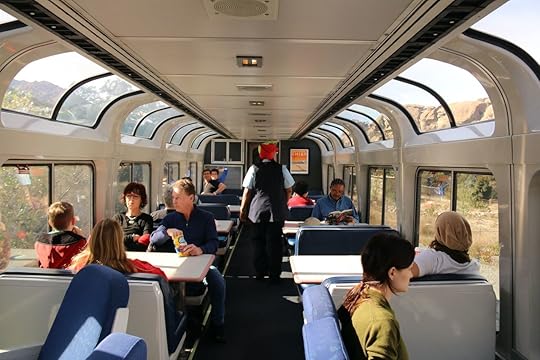
When I was 17, my dad made me an intriguing offer: If I wanted to visit my college of choice, I could take the Amtrak train from Seattle, stop in Erie, PA, to visit my aunt, and then continue on Amtrak to New York City. When he was just a little older than me, he worked for Amtrak and filled my childhood with motorized models that wound around his bedroom on miniature tracks. I said yes, forgoing the ease of a flight, because I had a romantic fantasy about train travel without thinking too hard about what long-distance train travel would entail on a practical level.
I quickly learned that a trip on Amtrak sends you hurtling through America without all of the modern conveniences to which most frequent travelers have become accustomed. There isn’t even WiFi on some of the trains. But that’s exactly why you need to experience it for yourself, at least once. It will jolt you out of your comfort zone in the best way possible.
My dad pushed me to accept the more expensive ticket for the sleeper car, but I insisted that I could ride coach no problem. I envisioned a cozy but rugged trip through the American wilderness without many luxuries. I was absolutely correct about everything but the coziness.
The Empire Builder took me from Seattle to Chicago, where I spent the day exploring the city with a friend before boarding the Capitol Limited to Pittsburgh. It was cold all the time, my seat was hard, and it was boring (I was still in my teens when I took the train in 2007, years before the iPhone became ubiquitous). I didn’t bring a blanket for the four day journey, and the stewardesses don’t stock extras (if you don’t spring for the sleeper car, don’t repeat my mistake). I don’t remember how I fell asleep on the train, but I do vividly recall collapsing in my aunt’s guest room when I arrived and sleeping peacefully for hours, grateful to be on solid ground.
That is probably not the ringing endorsement you were expecting.
Yet that trip, as uncomfortable as it was at times, had a profound effect on the way, and the reasons, I travel in adulthood — in part precisely because it required that I completely release myself from the expectations of what should happen on vacation.

Photo: ChaLii/Shutterstock
So much of going on vacation these days revolves around being entertained and served. At luxury hotels and resorts, your every desire is supposed to be met, and the priority is comfort and convenience. The point is to pamper yourself or indulge your family with gifts and experiences. On the train, the priority is quietly sitting and staring out a window, and I admit that at first it might not sound particularly exciting or appealing in a culture obsessed with social media and instant gratification.
The Empire Builder passes through some of American’s most unspoiled terrain: The wild forests of Montana near Glacier National Park, where I saw a Grizzly bear and her cubs watch the train pass from the edge of the tracks, and the untouched green hills of North Dakota. There was a lot of simply looking during that trip. I looked out the window all day, took blurry pictures with my first digital camera (which has since been misplaced), read, tried to write, and paced the train cars. I found an abandoned copy of Silent Spring (which I still have) in the quiet car and read that.
There was no list of activities to check off (except for stretching my legs at each local stop in Montana, Minnesota, North Dakota, and Wisconsin). There are few backdrops for Instagram-worthy selfies and group snapshots because the stunning landscapes outside the window are rushing by so quickly.
As a broke teenager, I only ate one or two meals in the sit-down dining car. The rest were supplied by the dining car’s cafe, so that meant a lot of sandwiches with rubbery cheese and hotdogs. So many people these days, myself included, travel all over the world just to try a certain restaurant or sample a local cuisine. A vacation success is sometimes even judged on how many enviable meals it involves.
But I also think that there is value in taking what you are given and making the best of it. There are no Michelin-star restaurants at the local train stations where the Empire Builder stops, no waiters that can take your pasta back because it’s undercooked. It’s simple, low maintenance food that forces you to be the same way.
I ate in my seat for nearly every meal, just thinking about my life back home and my future. It was a time to settle my priorities and decide what would be the most important tenets of my life moving forward: I resolved to move to New York City, where I stayed for the next decade before moving just across the water to Jersey City, where I’ve been ever since. I decided to take another shot at a relationship that would remain in my life for another two years. My determination to become a writer only strengthened in those quiet moments when I turned to my journal. It’s uncomfortable, especially now in the age of the smartphone, to sit with your own thoughts for long stretches of time. But it might conjure up a few unexpected revelations.

Photo: Amehime/Shutterstock
In an era where traveling by plane is much faster, and often cheaper, than train travel, Amtrak caters to a dying part of the American psyche — one that is patient and focused, that doesn’t demand attention or distraction. Peace of mind doesn’t always arrive on white-sand beaches or in the resort spa, and a vacation doesn’t always have to be an escape. Amtrak is certainly not an escape, at least not in the way most tourists are accustomed to. You are leaving home, but you will spend your time looking inward. And it’s well worth a little discomfort to experience the particular calm and peace of mind that a relatively uneventful — even monotonous — cross-country Amtrak trip can inspire. 
More like thisTrain Travel7 reasons your next trip should be by train
The post How an Amtrak trip from Seattle to Erie, PA, changed my life appeared first on Matador Network.

Airbnb’s virtual Broadway experience

Traditional plays and musicals aren’t exactly an option right now, so Airbnb is trying to fill the entertainment void and help artists who lost employment due to the COVID-19 pandemic. It partnered with The Actors Fund to offer new experiences hosted by artists and Broadway performers to keep a little Broadway shimmer in your life while the theaters themselves are dark.
The Broadway Online Experiences page invites viewers to “join live, interactive performances and conversations from Broadway and beyond. Without leaving home…Broadway’s back like never before. Learn the can-can from Moulin Rouge! The Musical, go behind the scenes with your favorite princesses, and meet the people keeping the magic of Broadway alive, online.”

Photo: Airbnb
The experiences include “Storytelling Through Song” with actor Tituss Burgess, “Broadway Princess Party” with stage Disney princesses Laura Osnes, Courtney Reed, and Susan Egan (who also voiced Megara in Hercules), dance lessons with the casts of Chicago and Moulin Rouge!, comedy improv classes, acting lessons, workouts, and more.
The experiences range from $15 to $60 each, and all proceeds from the experiences will go toward supporting artists financially while Broadway remains closed. According to an April 2020 survey by Americans for the Arts, 62 percent of artists have become unemployed during the pandemic, so there’s no question that relief is urgently needed. 
More like thisLGBTQ TravelThe Broadway shows you need to see in NYC: LGBTQ edition
The post Airbnb is launching immersive virtual experiences with your favorite Broadway stars appeared first on Matador Network.

Matador Network's Blog
- Matador Network's profile
- 6 followers



